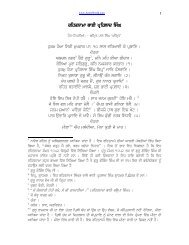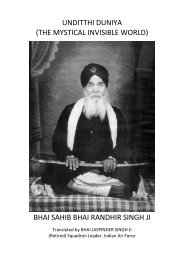Guru Gobind Singh's Death at Nanded Examination of - Vidhia.com
Guru Gobind Singh's Death at Nanded Examination of - Vidhia.com
Guru Gobind Singh's Death at Nanded Examination of - Vidhia.com
Create successful ePaper yourself
Turn your PDF publications into a flip-book with our unique Google optimized e-Paper software.
18 AN EXAMINATION OF SUCCESSION THEORIES<br />
and distorted beyond recognition. Their works on historical<br />
subjects are not, therefore, always, and in all respects, entirely<br />
truthful and dependable, and they should be studied with<br />
caution. Most <strong>of</strong> the Sikh Janam-Sakhls and Gur-bilas,<br />
Suraj Prakash and Panth Prakash type <strong>of</strong> liter<strong>at</strong>ure fall under<br />
this c<strong>at</strong>egory. The prose works after the Janam-sakhis, however,<br />
are <strong>com</strong>par<strong>at</strong>ively more factual and reliable.<br />
I have laboured this point <strong>at</strong> some length to show<br />
how fables and the supern<strong>at</strong>ural element have <strong>at</strong> some places<br />
<strong>com</strong>e to be introduced into the history <strong>of</strong> Sikh <strong>Guru</strong>s and<br />
how a number <strong>of</strong> their historical events have <strong>com</strong>e to be<br />
enshrouded in mystery.<br />
In the absence <strong>of</strong> reliable records and chronicles' <strong>of</strong><br />
the ancient period, we cannot easily say to wh<strong>at</strong> extent historical<br />
truths have thus suffered. But the case <strong>of</strong> the medieval •<br />
and modern periods is different. There is abundant reliable<br />
original, contemporary and semi-contemporary evidence<br />
available for <strong>com</strong>par<strong>at</strong>ive study <strong>of</strong> different versions <strong>of</strong> controversial<br />
events and for sifting fact from fiction. It is in the<br />
light <strong>of</strong> such m<strong>at</strong>erial th<strong>at</strong> we propose to examine here in<br />
the <strong>com</strong>ing paragraphs- the last event <strong>of</strong> the earthly life <strong>of</strong><br />
<strong>Guru</strong> <strong>Gobind</strong> Singh, i. e., his de<strong>at</strong>h <strong>at</strong> <strong>Nanded</strong> and the<br />
appointment <strong>of</strong> his successor.<br />
5. HISTORICAL RECORD ON THE GURU'S DEATH AT NANDED<br />
It will gre<strong>at</strong>ly help us understand the various points<br />
<strong>of</strong> this study if we know the different types <strong>of</strong> scholars who<br />
have written about the last days <strong>of</strong> <strong>Guru</strong> <strong>Gobind</strong> Singh <strong>at</strong><br />
<strong>Nanded</strong>. First <strong>of</strong> all, there are those who were then present<br />
<strong>at</strong> <strong>Nanded</strong> or had been in its neighbourhood and had unmistakable<br />
knowledge <strong>of</strong> his de<strong>at</strong>h. To this type also belong<br />
those who had known the <strong>Guru</strong> personally, had met his<br />
<strong>com</strong>panions and had received first-hand inform<strong>at</strong>ion about<br />
the end <strong>of</strong> his life.<br />
The second type <strong>com</strong>prises the un<strong>at</strong>tached scholars who<br />
have written on this topic purely from historical point <strong>of</strong><br />
view. Only such <strong>of</strong> them have taken notice <strong>of</strong> his last <strong>com</strong>mand<br />
and farewell message as had studied the growth and<br />
GURU GOBIND SINGH S DEATH AT NANDED 19<br />
development <strong>of</strong> the Sikh movement from the time <strong>of</strong> <strong>Guru</strong><br />
Nanak and were interested in the religious life <strong>of</strong> the Sikh<br />
people after the de<strong>at</strong>h <strong>of</strong> their last <strong>Guru</strong>. They are mostly<br />
non-Sikhs — Hindus, Muslims and Christians.<br />
The Sikh writers mostly belong to the eulogistic type.<br />
In their deep devotion and overflowing enthusiasm they have<br />
<strong>at</strong> times allowed full and free play to their imagin<strong>at</strong>ion in<br />
keeping with the tradition <strong>of</strong> their ancient Hindu precursors.<br />
In their effort to place the Sikh <strong>Guru</strong>s on a par with, if not<br />
above, the prophets <strong>of</strong> other religions in the working <strong>of</strong><br />
miracles, they seem not only to have borrowed and adapted<br />
some <strong>of</strong> their myths but have also invented a number <strong>of</strong><br />
them to embellish their narr<strong>at</strong>ives. The myth about <strong>Guru</strong><br />
<strong>Gobind</strong> Singh having been seen in the jungle by a wood-seller<br />
or an ascetic Sadhu in the morning following his de<strong>at</strong>h and<br />
crem<strong>at</strong>ion has apparently <strong>com</strong>e from Christian tradition<br />
wherein Lord Jesus Christ is st<strong>at</strong>ed to have been seen alive and<br />
walking on the road after his crucific<strong>at</strong>ion and de<strong>at</strong>h. Or, it<br />
may be the cre<strong>at</strong>ion <strong>of</strong> the superstitious mind not willing to<br />
acknowledge the fact th<strong>at</strong> a religious prophet such as <strong>Guru</strong><br />
<strong>Gobind</strong> Singh could leave the mortal coil like an ordinary<br />
human being.<br />
To <strong>com</strong>e to the story <strong>of</strong> the de<strong>at</strong>h <strong>of</strong> <strong>Guru</strong> <strong>Gobind</strong><br />
Singh. It is agreed on all hands th<strong>at</strong>, while <strong>at</strong> <strong>Nanded</strong>, he<br />
was one evening stabbed by a P<strong>at</strong>han and th<strong>at</strong> his wound<br />
was stitched and bandaged by a surgeon sent by Emperor<br />
Bahadur Shah. It is also accepted without doubt th<strong>at</strong> his<br />
imperfectly healed wound burst open when the <strong>Guru</strong> bent a<br />
stiff bow presented to him by a visitor.<br />
The news <strong>of</strong> the de<strong>at</strong>h <strong>of</strong> <strong>Guru</strong> <strong>Gobind</strong> Singh finds a<br />
prominent mention in the Royal Court News, the Akhbardt-i-<br />
Darbar-i-Mualla, <strong>of</strong> October-November 1708 A. D. and in<br />
the Bahadur Shah Noma in a number <strong>of</strong> places. Emperor<br />
Bahadur Shah had crossed the river Godavri on October 7,<br />
1708, to quell the rebellion <strong>of</strong> his younger brother Kam<br />
Bakhsh before the news about the de<strong>at</strong>h <strong>of</strong> the <strong>Guru</strong> was reported<br />
to him. For the next three weeks^he was extremely busy




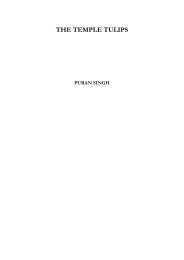
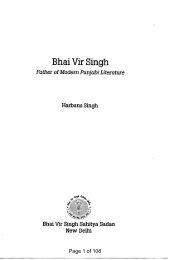

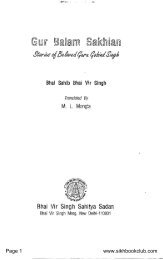
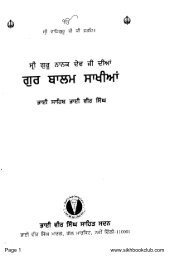
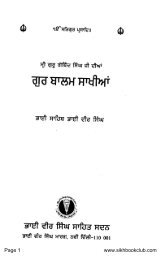
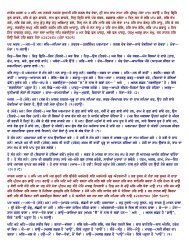
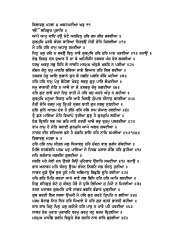

![cOpeI ] hmrI kro hwQ dY r~Cw ] pUrn hoie ic~q kI ie ... - Vidhia.com](https://img.yumpu.com/12240258/1/190x245/copei-hmri-kro-hwq-dy-rcw-purn-hoie-icq-ki-ie-vidhiacom.jpg?quality=85)
